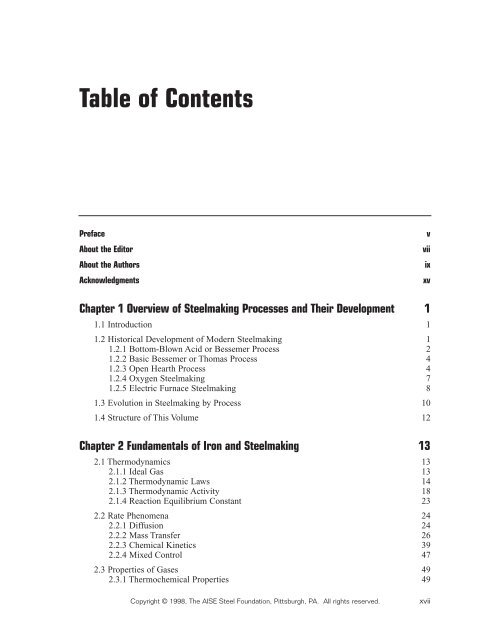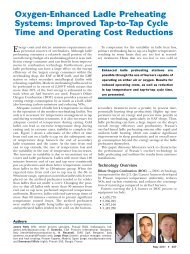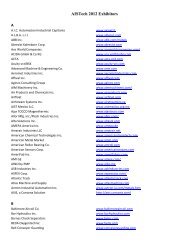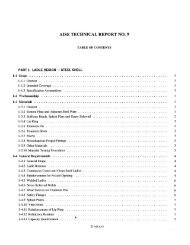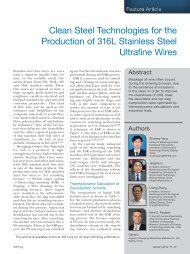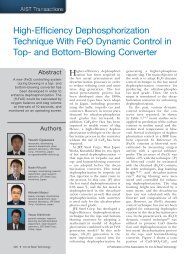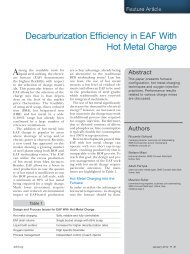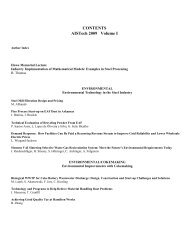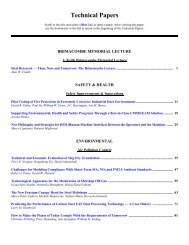Table of Contents - Steel Library
Table of Contents - Steel Library
Table of Contents - Steel Library
Create successful ePaper yourself
Turn your PDF publications into a flip-book with our unique Google optimized e-Paper software.
<strong>Table</strong> <strong>of</strong> <strong>Contents</strong><br />
Preface v<br />
About the Editor vii<br />
About the Authors ix<br />
Acknowledgments xv<br />
Chapter 1 Overview <strong>of</strong> <strong>Steel</strong>making Processes and Their Development 1<br />
1.1 Introduction 1<br />
1.2 Historical Development <strong>of</strong> Modern <strong>Steel</strong>making 1<br />
1.2.1 Bottom-Blown Acid or Bessemer Process 2<br />
1.2.2 Basic Bessemer or Thomas Process 4<br />
1.2.3 Open Hearth Process 4<br />
1.2.4 Oxygen <strong>Steel</strong>making 7<br />
1.2.5 Electric Furnace <strong>Steel</strong>making 8<br />
1.3 Evolution in <strong>Steel</strong>making by Process 10<br />
1.4 Structure <strong>of</strong> This Volume 12<br />
Chapter 2 Fundamentals <strong>of</strong> Iron and <strong>Steel</strong>making 13<br />
2.1 Thermodynamics 13<br />
2.1.1 Ideal Gas 13<br />
2.1.2 Thermodynamic Laws 14<br />
2.1.3 Thermodynamic Activity 18<br />
2.1.4 Reaction Equilibrium Constant 23<br />
2.2 Rate Phenomena 24<br />
2.2.1 Diffusion 24<br />
2.2.2 Mass Transfer 26<br />
2.2.3 Chemical Kinetics 39<br />
2.2.4 Mixed Control 47<br />
2.3 Properties <strong>of</strong> Gases 49<br />
2.3.1 Thermochemical Properties 49<br />
Copyright © 1998, The AISE <strong>Steel</strong> Foundation, Pittsburgh, PA. All rights reserved. xvii
<strong>Steel</strong>making and Refining Volume<br />
2.3.2 Transport Properties 55<br />
2.3.3 Pore Diffusion 57<br />
2.4 Properties <strong>of</strong> Molten <strong>Steel</strong> 60<br />
2.4.1 Selected Thermodynamic Data 60<br />
2.4.2 Solubility <strong>of</strong> Gases in Liquid Iron 61<br />
2.4.3 Iron-Carbon Alloys 64<br />
2.4.4 Liquidus Temperatures <strong>of</strong> Low Alloy <strong>Steel</strong>s 69<br />
2.4.5 Solubility <strong>of</strong> Iron Oxide in Liquid Iron 69<br />
2.4.6 Elements <strong>of</strong> Low Solubility in Liquid Iron 70<br />
2.4.7 Surface Tension 72<br />
2.4.8 Density 75<br />
2.4.9 Viscosity 75<br />
2.4.10 Diffusivity, Electrical and Thermal Conductivity, and Thermal Diffusivity 76<br />
2.5 Properties <strong>of</strong> Molten Slags 79<br />
2.5.1 Structural Aspects 79<br />
2.5.2 Slag Basicity 80<br />
2.5.3 Iron Oxide in Slags 81<br />
2.5.4 Selected Ternary and Quaternary Oxide Systems 81<br />
2.5.5 Oxide Activities in Slags 84<br />
2.5.6 Gas Solubility in Slags 89<br />
2.5.7 Surface Tension 95<br />
2.5.8 Density 98<br />
2.5.9 Viscosity 100<br />
2.5.10 Mass Diffusivity, Electrical Conductivity and Thermal Conductivity 101<br />
2.5.11 Slag Foaming 102<br />
2.5.12 Slag Models and Empirical Correlations for Thermodynamic Properties 104<br />
2.6 Fundamentals <strong>of</strong> Ironmaking Reactions 104<br />
2.6.1 Oxygen Potential Diagram 104<br />
2.6.2 Role <strong>of</strong> Vapor Species in Blast Furnace Reactions 105<br />
2.6.3 Slag-Metal Reactions in the Blast Furnace 109<br />
2.7 Fundamentals <strong>of</strong> <strong>Steel</strong>making Reactions 118<br />
2.7.1 Slag-Metal Equilibrium in <strong>Steel</strong>making 119<br />
2.7.2 State <strong>of</strong> Reactions in <strong>Steel</strong>making 123<br />
2.8 Fundamentals <strong>of</strong> Reactions in Electric Furnace <strong>Steel</strong>making<br />
2.8.1 Slag Chemistry and the Carbon, Manganese, Sulfur and<br />
132<br />
Phosphorus Reactions in the EAF 132<br />
2.8.2 Control <strong>of</strong> Residuals in EAF <strong>Steel</strong>making 134<br />
2.8.3 Nitrogen Control in EAF <strong>Steel</strong>making 135<br />
2.9 Fundamentals <strong>of</strong> Stainless <strong>Steel</strong> Production 136<br />
2.9.1 Decarburization <strong>of</strong> Stainless <strong>Steel</strong> 136<br />
2.9.2 Nitrogen Control in the AOD 138<br />
2.9.3 Reduction <strong>of</strong> Cr from Slag 139<br />
2.10 Fundamentals <strong>of</strong> Ladle Metallurgical Reactions 140<br />
2.10.1 Deoxidation Equilibrium and Kinetics 140<br />
2.10.2 Ladle Desulfurization 147<br />
2.10.3 Calcium Treatment <strong>of</strong> <strong>Steel</strong> 150<br />
2.11 Fundamentals <strong>of</strong> Degassing 151<br />
2.11.1 Fundamental Thermodynamics 151<br />
2.11.2 Vacuum Degassing Kinetics 152<br />
xviii Copyright © 1998, The AISE <strong>Steel</strong> Foundation, Pittsburgh, PA. All rights reserved.
<strong>Table</strong> <strong>of</strong> <strong>Contents</strong><br />
Chapter 3 <strong>Steel</strong> Plant Refractories 159<br />
3.1 Classification <strong>of</strong> Refractories 159<br />
3.1.1 Magnesia or Magnesia–Lime Group 160<br />
3.1.2 Magnesia–Chrome Group 163<br />
3.1.3 Siliceous Group 164<br />
3.1.4 Clay and High-Alumina Group 166<br />
3.1.5 Processed Alumina Group 169<br />
3.1.6 Carbon Group 170<br />
3.2 Preparation <strong>of</strong> Refractories 172<br />
3.2.1 Refractory Forms 172<br />
3.2.2 Binder Types 173<br />
3.2.3 Processing 176<br />
3.2.4 Products<br />
3.3 Chemical and Physical Characteristics <strong>of</strong> Refractories<br />
177<br />
and their Relation to Service Conditions 178<br />
3.3.1 Chemical Composition 178<br />
3.3.2 Density and Porosity 179<br />
3.3.3 Refractoriness 181<br />
3.3.4 Strength 182<br />
3.3.5 Stress-Strain Behavior 185<br />
3.3.6 Specific Heat 186<br />
3.3.7 Emissivity 187<br />
3.3.8 Thermal Expansion 188<br />
3.3.9 Thermal Conductivity and Heat Transfer 190<br />
3.3.10 Thermal Shock 194<br />
3.4 Reactions at Elevated Temperatures 194<br />
3.5 Testing and Selection <strong>of</strong> Refractories 206<br />
3.5.1 Simulated Service Tests 206<br />
3.5.2 Post-Mortem Studies 212<br />
3.5.3 Thermomechanical Behavior 213<br />
3.6 General Uses <strong>of</strong> Refractories 215<br />
3.6.1 Linings 215<br />
3.6.2 Metal Containment, Control and Protection 217<br />
3.6.3 Refractory Use for Energy Savings 222<br />
3.7 Refractory Consumption, Trends and Costs 224<br />
Chapter 4 <strong>Steel</strong>making Refractories 227<br />
4.1 Refractories for Oxygen <strong>Steel</strong>making Furnaces 227<br />
4.1.1 Introduction 227<br />
4.1.2 Balancing Lining Wear 228<br />
4.1.3 Zoned Linings by Brick Type and Thickness 230<br />
4.1.4 Refractory Construction 231<br />
4.1.5 Furnace Burn-In 235<br />
4.1.6 Wear <strong>of</strong> the Lining 235<br />
4.1.7 Lining Life and Costs 238<br />
4.2 BOF Slag Coating and Slag Splashing 239<br />
4.2.1 Introduction 239<br />
Copyright © 1998, The AISE <strong>Steel</strong> Foundation, Pittsburgh, PA. All rights reserved. xix
<strong>Steel</strong>making and Refining Volume<br />
4.2.2 Slag Coating Philosophy 239<br />
4.2.3 Magnesia Levels and Influences 239<br />
4.2.4 Material Additions 240<br />
4.2.5 Equilibrium Operating Lining Thickness 240<br />
4.2.6 Other Refractory Maintenance Practices 241<br />
4.2.7 Laser Measuring 241<br />
4.2.8 Slag Splashing 241<br />
4.3 Refractories for Electric Furnace <strong>Steel</strong>making 243<br />
4.3.1 Electric Furnace Design Features 243<br />
4.3.2 Electric Furnace Zone Patterns 244<br />
4.3.3 Electric Furnace Refractory Wear Mechanisms 247<br />
4.3.4 Conclusion 248<br />
4.4 Refractories for AOD and VOD Applications 248<br />
4.4.1 Background 248<br />
4.4.2 AOD Refractories 249<br />
4.4.3 VOD Refractories 258<br />
4.4.4 Acknowledgments 261<br />
4.5 Refractories for Ladles 262<br />
4.5.1 Function <strong>of</strong> Modern <strong>Steel</strong> Ladle 262<br />
4.5.2 Ladle Design 265<br />
4.5.3 Ladle Refractory Design and Use 268<br />
4.5.4 Ladle Refractory Construction 276<br />
4.5.5 Refractory Stirring Plugs 277<br />
4.5.6 Refractory Life and Costs 281<br />
4.6 Refractories for Degassers 285<br />
Chapter 5 Production and Use <strong>of</strong> Industrial Gases for<br />
Iron and <strong>Steel</strong>making 291<br />
5.1 Industrial Gas Uses 291<br />
5.1.1 Introduction 291<br />
5.1.2 Oxygen Uses 292<br />
5.1.3 Nitrogen Uses 294<br />
5.1.4 Argon Uses 295<br />
5.1.5 Hydrogen Uses 296<br />
5.1.6 Carbon Dioxide Uses 296<br />
5.2 Industrial Gas Production 297<br />
5.2.1 Introduction 297<br />
5.2.2 Atmospheric Gases Produced by Cryogenic Processes 298<br />
5.2.3 Atmospheric Gases Produced by PSA/VSA/VPSA Membranes 302<br />
5.2.4 Hydrogen Production 305<br />
5.2.5 Carbon Dioxide Production 305<br />
5.3 Industrial Gas Supply System Options and Considerations 306<br />
5.3.1 Introduction 306<br />
5.3.2 Number <strong>of</strong> Gases 306<br />
5.3.3 Purity <strong>of</strong> Gases 307<br />
5.3.4 Volume <strong>of</strong> Gases 307<br />
5.3.5 Use Pressure 307<br />
5.3.6 Use Pattern 307<br />
5.3.7 Cost <strong>of</strong> Power 307<br />
xx Copyright © 1998, The AISE <strong>Steel</strong> Foundation, Pittsburgh, PA. All rights reserved.
<strong>Table</strong> <strong>of</strong> <strong>Contents</strong><br />
5.3.8 Backup Requirements 307<br />
5.3.9 Integration 307<br />
5.4 Industrial Gas Safety 307<br />
5.4.1 Oxygen 308<br />
5.4.2 Nitrogen 308<br />
5.4.3 Argon 308<br />
5.4.4 Hydrogen 309<br />
5.4.5 Carbon Dioxide 309<br />
Chapter 6 <strong>Steel</strong> Plant Fuels and Water Requirements 311<br />
6.1 Fuels, Combustion and Heat Flow 311<br />
6.1.1 Classification <strong>of</strong> Fuels 311<br />
6.1.2 Principles <strong>of</strong> Combustion 312<br />
6.1.3 Heat Flow 326<br />
6.2 Solid Fuels and Their Utilization 329<br />
6.2.1 Coal Resources 330<br />
6.2.2 Mining <strong>of</strong> Coal 336<br />
6.2.3 Coal Preparation 339<br />
6.2.4 Carbonization <strong>of</strong> Coal 341<br />
6.2.5 Combustion <strong>of</strong> Solid Fuels 341<br />
6.3 Liquid Fuels and Their Utilization 344<br />
6.3.1 Origin, Composition and Distribution <strong>of</strong> Petroleum 345<br />
6.3.2 Grades <strong>of</strong> Petroleum Used as Fuels 347<br />
6.3.3 Properties and Specifications <strong>of</strong> Liquid Fuels 348<br />
6.3.4 Combustion <strong>of</strong> Liquid Fuels 351<br />
6.3.5 Liquid-Fuel Burners 351<br />
6.4 Gaseous Fuels and Their Utilization 352<br />
6.4.1 Natural Gas 353<br />
6.4.2 Manufactured Gases 353<br />
6.4.3 Byproduct Gaseous Fuels 356<br />
6.4.4 Uses for Various Gaseous Fuels in the <strong>Steel</strong> Industry 358<br />
6.4.5 Combustion <strong>of</strong> Various Gaseous Fuels 360<br />
6.5 Fuel Economy 363<br />
6.5.1 Recovery <strong>of</strong> Waste Heat 364<br />
6.5.2 Minimizing Radiation Losses 366<br />
6.5.3 Combustion Control 366<br />
6.5.4 Air Infiltration 367<br />
6.5.5 Heating Practice 368<br />
6.6 Water Requirements for <strong>Steel</strong>making 368<br />
6.6.1 General Uses for Water in <strong>Steel</strong>making 368<br />
6.6.2 Water-Related Problems 371<br />
6.6.3 Water Use by <strong>Steel</strong>making Processes 372<br />
6.6.4 Treatment <strong>of</strong> Effluent Water 379<br />
6.6.5 Effluent Limitations 385<br />
6.6.6 Boiler Water Treatment 395<br />
Chapter 7 Pre-Treatment <strong>of</strong> Hot Metal 413<br />
7.1 Introduction 413<br />
7.2 Desiliconization and Dephosphorization Technologies 413<br />
Copyright © 1998, The AISE <strong>Steel</strong> Foundation, Pittsburgh, PA. All rights reserved. xxi
<strong>Steel</strong>making and Refining Volume<br />
7.3 Desulfurization Technology 416<br />
7.3.1 Introduction 416<br />
7.3.2 Process Chemistry 417<br />
7.3.3 Transport Systems 421<br />
7.3.4 Process Venue 422<br />
7.3.5 Slag Management 423<br />
7.3.6 Lance Systems 424<br />
7.3.7 Cycle Time 426<br />
7.3.8 Hot Metal Sampling and Analysis 426<br />
7.3.9 Reagent Consumption 426<br />
7.3.10 Economics 427<br />
7.3.11 Process Control 427<br />
7.4 Hot Metal Thermal Adjustment 427<br />
7.5 Acknowledgments 428<br />
7.6 Other Reading 428<br />
Chapter 8 Oxygen <strong>Steel</strong>making Furnace Mechanical Description<br />
and Maintenance Considerations 431<br />
8.1 Introduction 431<br />
8.2 Furnace Description 431<br />
8.2.1 Introduction 431<br />
8.2.2 Vessel Shape 433<br />
8.2.3 Top Cone-to-Barrel Attachment 434<br />
8.2.4 Methods <strong>of</strong> Top Cone Cooling 435<br />
8.2.5 Vessel Bottom 438<br />
8.2.6 Types <strong>of</strong> Trunnion Ring Designs 438<br />
8.2.7 Methods <strong>of</strong> Vessel Suspension 439<br />
8.2.8 Vessel Imbalance 445<br />
8.2.9 Refractory Lining Design 446<br />
8.2.10 Design Temperatures 448<br />
8.2.11 Design Pressures and Loading 451<br />
8.2.12 Method <strong>of</strong> Predicting Vessel Life 457<br />
8.2.13 Special Design and Operating Considerations 458<br />
8.3 Materials 460<br />
8.4 Service Inspection, Repair, Alteration and Maintenance 460<br />
8.4.1 BOF Inspection 460<br />
8.4.2 BOF Repair and Alteration Procedures 462<br />
8.4.3 Repair Requirements <strong>of</strong> Structural Components 463<br />
8.4.4 Deskulling 464<br />
8.5 Oxygen Lance Technology 465<br />
8.5.1 Introduction 465<br />
8.5.2 Oxidation Reactions 465<br />
8.5.3 Supersonic Jet Theory 466<br />
8.5.4 Factors Affecting BOF Lance Performance 468<br />
8.5.5 Factors Affecting BOF Lance Life 469<br />
8.5.6 New Developments in BOF Lances 470<br />
8.6 Sub-Lance Equipment 471<br />
xxii Copyright © 1998, The AISE <strong>Steel</strong> Foundation, Pittsburgh, PA. All rights reserved.
<strong>Table</strong> <strong>of</strong> <strong>Contents</strong><br />
Chapter 9 Oxygen <strong>Steel</strong>making Processes 475<br />
9.1 Introduction 475<br />
9.1.1 Process Description and Events 475<br />
9.1.2 Types <strong>of</strong> Oxygen <strong>Steel</strong>making Processes 476<br />
9.1.3 Environmental Issues 477<br />
9.1.4 How to Use This Chapter 477<br />
9.2 Sequences <strong>of</strong> Operations—Top Blown 478<br />
9.2.1 Plant Layout 478<br />
9.2.2 Sequence <strong>of</strong> Operations 478<br />
9.2.3 Shop Manning 486<br />
9.3 Raw Materials 489<br />
9.3.1 Introduction 489<br />
9.3.2 Hot Metal 489<br />
9.3.3 Scrap 491<br />
9.3.4 High Metallic Alternative Feeds 491<br />
9.3.5 Oxide Additions 493<br />
9.3.6 Fluxes 494<br />
9.3.7 Oxygen 495<br />
9.4 Process Reactions and Energy Balance 496<br />
9.4.1 Refining Reactions in BOF <strong>Steel</strong>making 496<br />
9.4.2 Slag Formation in BOF <strong>Steel</strong>making 498<br />
9.4.3 Mass and Energy Balances 499<br />
9.4.4 Tapping Practices and Ladle Additions 503<br />
9.5 Process Variations 504<br />
9.5.1 The Bottom-Blown Oxygen <strong>Steel</strong>making or OBM (Q-BOP) Process 504<br />
9.5.2 Mixed-Blowing Processes 507<br />
9.5.3 Oxygen <strong>Steel</strong>making Practice Variations 512<br />
9.6 Process Control Strategies 515<br />
9.6.1 Introduction 515<br />
9.6.2 Static Models 515<br />
9.6.3 Statistical and Neural Network Models 516<br />
9.6.4 Dynamic Control Schemes 517<br />
9.6.5 Lance Height Control 519<br />
9.7 Environmental Issues 519<br />
9.7.1 Basic Concerns 519<br />
9.7.2 Sources <strong>of</strong> Air Pollution 519<br />
9.7.3 Relative Amounts <strong>of</strong> Fumes Generated 521<br />
9.7.4 Other Pollution Sources 522<br />
9.7.5 Summary 522<br />
Chapter 10 Electric Furnace <strong>Steel</strong>making 525<br />
10.1 Furnace Design 525<br />
10.1.1 EAF Mechanical Design 525<br />
10.1.2 EAF Refractories 545<br />
10.2 Furnace Electric System and Power Generation 551<br />
10.2.1 Electrical Power Supply 551<br />
10.2.2 Furnace Secondary System 554<br />
10.2.3 Regulation 555<br />
Copyright © 1998, The AISE <strong>Steel</strong> Foundation, Pittsburgh, PA. All rights reserved. xxiii
<strong>Steel</strong>making and Refining Volume<br />
10.2.4 Electrical Considerations for AC Furnaces 557<br />
10.2.5 Electrical Considerations for DC Furnaces 560<br />
10.3 Graphite Electrodes 562<br />
10.3.1 Electrode Manufacture 562<br />
10.3.2 Electrode Properties 564<br />
10.3.3 Electrode Wear Mechanisms 564<br />
10.3.4 Current Carrying Capacity 569<br />
10.3.5 Discontinuous Consumption Processes 569<br />
10.3.6 Comparison <strong>of</strong> AC and DC Electrode Consumption 572<br />
10.3.7 Development <strong>of</strong> Special DC Electrode Grades 575<br />
10.4 Gas Collection and Cleaning 577<br />
10.4.1 Early Fume Control Methods 577<br />
10.4.2 Modern EAF Fume Control 579<br />
10.4.3 Secondary Emissions Control 583<br />
10.4.4 Gas Cleaning 586<br />
10.4.5 Mechanisms <strong>of</strong> EAF Dust Formation 590<br />
10.4.6 Future Environmental Concerns 590<br />
10.4.7 Conclusions 594<br />
10.5 Raw Materials 594<br />
10.6 Fluxes and Additives 595<br />
10.7 Electric Furnace Technology 597<br />
10.7.1 Oxygen Use in the EAF 597<br />
10.7.2 Oxy-Fuel Burner Application in the EAF 598<br />
10.7.3 Application <strong>of</strong> Oxygen Lancing in the EAF 601<br />
10.7.4 Foamy Slag Practice 604<br />
10.7.5 CO Post-Combustion 605<br />
10.7.6 EAF Bottom Stirring 615<br />
10.7.7 Furnace Electrics 617<br />
10.7.8 High Voltage AC Operations 617<br />
10.7.9 DC EAF Operations 618<br />
10.7.10 Use <strong>of</strong> Alternative Iron Sources in the EAF 621<br />
10.7.11 Conclusions 622<br />
10.8 Furnace Operations 622<br />
10.8.1 EAF Operating Cycle 622<br />
10.8.2 Furnace Charging 623<br />
10.8.3 Melting 624<br />
10.8.4 Refining 624<br />
10.8.5 Deslagging 626<br />
10.8.6 Tapping 627<br />
10.8.7 Furnace Turnaround 627<br />
10.8.8 Furnace Heat Balance 628<br />
10.9 New Scrap Melting Processes 629<br />
10.9.1 Scrap Preheating 629<br />
10.9.2 Preheating With Offgas 630<br />
10.9.3 Natural Gas Scrap Preheating 630<br />
10.9.4 K-ES 631<br />
10.9.5 Danarc Process 634<br />
10.9.6 Fuchs Shaft Furnace 635<br />
10.9.7 Consteel Process 642<br />
10.9.8 Twin Shell Electric Arc Furnace 645<br />
10.9.9 Processes Under Development 648<br />
xxiv Copyright © 1998, The AISE <strong>Steel</strong> Foundation, Pittsburgh, PA. All rights reserved.
<strong>Table</strong> <strong>of</strong> <strong>Contents</strong><br />
Chapter 11 Ladle Refining and Vacuum Degassing 661<br />
11.1 Tapping the <strong>Steel</strong> 662<br />
11.1.1 Reactions Occurring During Tapping 662<br />
11.1.2 Furnace Slag Carryover 663<br />
11.1.3 Chilling Effect <strong>of</strong> Ladle Additions 664<br />
11.2 The Tap Ladle 665<br />
11.2.1 Ladle Preheating 665<br />
11.2.2 Ladle Free Open Performance 667<br />
11.2.3 Stirring in Ladles 669<br />
11.2.4 Effect <strong>of</strong> Stirring on Inclusion Removal 672<br />
11.3 Reheating <strong>of</strong> the Bath 673<br />
11.3.1 Arc Reheating 673<br />
11.3.2 Reheating by Oxygen Injection 675<br />
11.4 Refining in the Ladle 677<br />
11.4.1 Deoxidation 677<br />
11.4.2 Desulfurization 680<br />
11.4.3 Dephosphorization 683<br />
11.4.4 Alloy Additions 685<br />
11.4.5 Calcium Treatment and Inclusion Modification 687<br />
11.5 Vacuum Degassing 693<br />
11.5.1 General Process Descriptions 694<br />
11.5.2 Vacuum Carbon Deoxidation 694<br />
11.5.3 Hydrogen Removal 698<br />
11.5.4 Nitrogen Removal 701<br />
11.6 Description <strong>of</strong> Selected Processes 705<br />
11.6.1 Ladle Furnace 705<br />
11.6.2 Tank Degasser 705<br />
11.6.3 Vacuum Arc Degasser 705<br />
11.6.4 RH Degasser 708<br />
11.6.5 CAS-OB Process 709<br />
11.6.6 Process Selection and Comparison 710<br />
Chapter 12 Refining <strong>of</strong> Stainless <strong>Steel</strong>s 715<br />
12.1 Introduction 715<br />
12.2 Special Considerations in Refining Stainless <strong>Steel</strong>s 720<br />
12.3 Selection <strong>of</strong> a Process Route 721<br />
12.4 Raw Materials 723<br />
12.5 Melting 724<br />
12.5.1 Electric Arc Furnace Melting 724<br />
12.5.2 Converter Melting 725<br />
12.6 Dilution Refining Processes 725<br />
12.6.1 Argon-Oxygen Decarburization (AOD) Converter Process 725<br />
12.6.2 K-BOP and K-OBM-S 726<br />
12.6.3 Metal Refining Process (MRP) Converter 727<br />
12.6.4 Creusot-Loire-Uddeholm (CLU) Converter 727<br />
12.6.5 Krupp Combined Blowing-Stainless (KCB-S) Process 728<br />
12.6.6 Argon Secondary Melting (ASM) Converter 728<br />
Copyright © 1998, The AISE <strong>Steel</strong> Foundation, Pittsburgh, PA. All rights reserved. xxv
<strong>Steel</strong>making and Refining Volume<br />
12.6.7 Sumitomo Top and Bottom Blowing Process (STB) Converter 729<br />
12.6.8 Top Mixed Bottom Inert (TMBI) Converter 729<br />
12.6.9 Combined Converter and Vacuum Units 729<br />
12.7 Vacuum Refining Processes 729<br />
12.8 Direct Stainless <strong>Steel</strong>making 730<br />
12.9 Equipment for EAF-AOD Process 732<br />
12.9.1 Vessel Size and Shape 732<br />
12.9.2 Refractories 733<br />
12.9.3 Tuyeres and Plugs 733<br />
12.9.4 Top Lances 733<br />
12.9.5 Gases 734<br />
12.9.6 Vessel Drive System 734<br />
12.9.7 Emissions Collection 735<br />
12.10 Vessel Operation 735<br />
12.10.1 Decarburization 735<br />
12.10.2 Refining 737<br />
12.10.3 Process Control 737<br />
12.10.4 Post-Vessel Treatments 738<br />
12.11 Summary 738<br />
Chapter 13 Alternative Oxygen <strong>Steel</strong>making Processes 743<br />
13.1 Introduction 743<br />
13.2 General Principles and Process Types 743<br />
13.3 Specific Alternative <strong>Steel</strong>making Processes 745<br />
13.3.1 Energy Optimizing Furnace (EOF) 746<br />
13.3.2 AISI Continuous Refining 748<br />
13.3.3 IRSID Continuous <strong>Steel</strong>making 749<br />
13.3.4 Trough Process 752<br />
13.3.5 Other <strong>Steel</strong>making Alternatives 753<br />
13.4 Economic Evaluation 755<br />
13.5 Summary and Conclusions 757<br />
Index 761<br />
xxvi Copyright © 1998, The AISE <strong>Steel</strong> Foundation, Pittsburgh, PA. All rights reserved.


